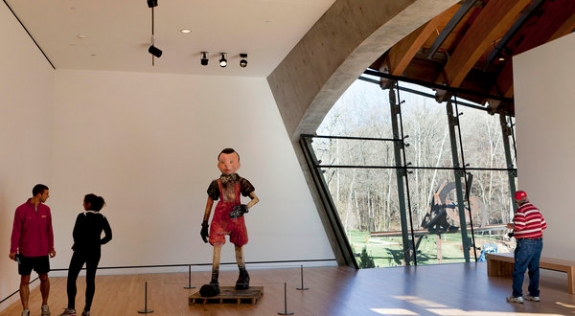By just about any measure, the Crystal Bridges Museum of American Art, which opened last month in this small town in northwest Arkansas, is off to a running start. The dream-come-true of Alice Walton, an heir to the Walmart fortune, it is characterized by people both inside and outside the museum as a work in progress, with plenty of room for improvement. But there it stands, a big, serious, confident, new institution with more than 50,000 square feet of gallery space and a collection worth hundreds of millions of dollars in a region almost devoid of art museums.
Much more than just a demonstration of what money can buy or an attempt to burnish a rich family’s name, Crystal Bridges is poised to make a genuine cultural contribution, and possibly to become a place of pilgrimage for art lovers from around the world.
It came into being in record time: it was only in May 2005 that Ms. Walton announced the selection of the Israeli-born Boston architect Moshe Safdie to design the museum and ruffled feathers along the Eastern Seaboard by buying a landmark of Hudson River School landscape painting, “Kindred Spirits,” by Asher B. Durand, from the New York Public Library for around $35 million. The purchase came early in an extended shopping spree that rattled nerves, aroused skepticism and stimulated the art market.
Today Crystal Bridges has a spacious and comfortable, if rather coarsely detailed, home set into a beautiful ravine carved by the Crystal Spring, from whence comes the name. (The land was once part of the Walton family property in Bentonville, where Ms. Walton’s father, Sam Walton, opened his first five-and-dime in 1951.) And it has a collection, spanning colonial times to the present, substantial enough to merit the use of the word “masterworks” in the title of its opening exhibition. This display of more than 400 paintings, sculptures and works on paper includes efforts by revered artists like Gilbert Stuart, Thomas Cole and Thomas Eakins and is especially outstanding in its representation of early-20th-century Modernism, with wonderful clusters of paintings by Marsden Hartley and Stuart Davis and two fabulous canvases by Arthur Dove.
The museum also has the beginning of a distinctive mission, which is to tie together American art and history and the immediate experience of nature in a compelling and accessible way, one that still keeps the art very much in the foreground.
This mission seems built into Mr. Safdie’s design, which consists of eight linked pavilions that border or span two large pools that are fed by the spring (and that unfortunately were empty and still being worked on when I visited this month). In a way that seems slightly confused, the arrangement evokes aspects of the Getty’s hilltop campus in Los Angeles, of Frank Lloyd Wright’s Fallingwater in western Pennsylvania and of a fancy theme park, minus the rides.
But there is an undeniable brilliance to this physical dispersal; you are never far from the outdoors, never cocooned by a maze of galleries. Moving through the building becomes something of a tour of its remarkable setting.



